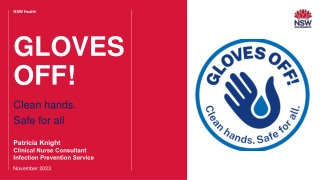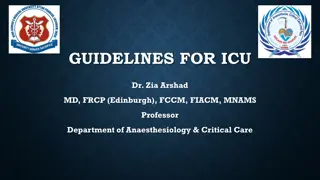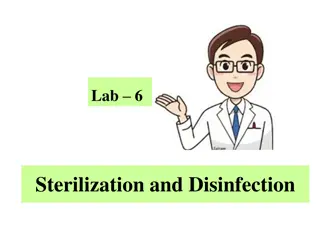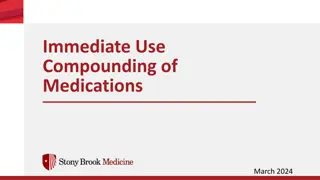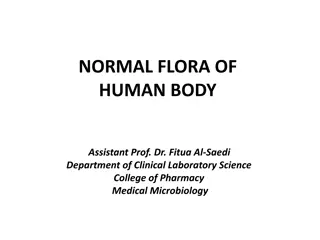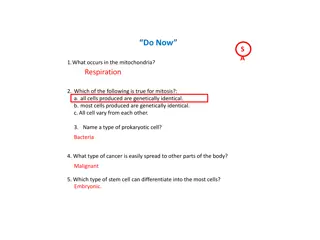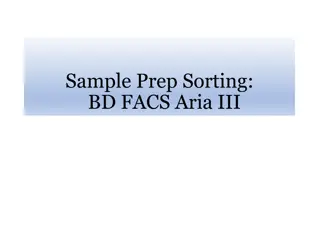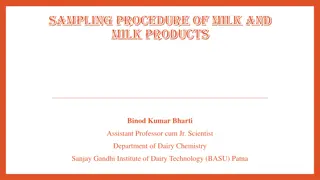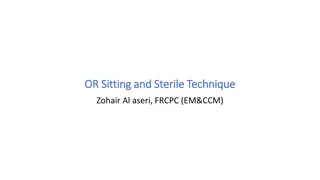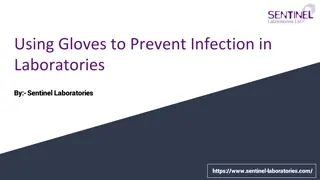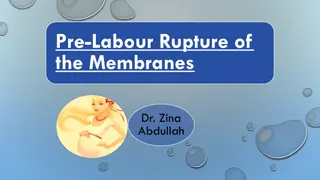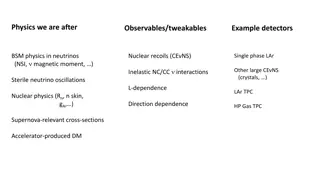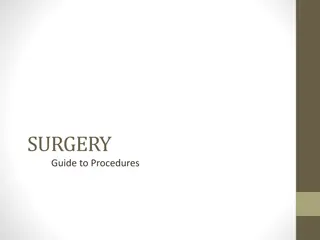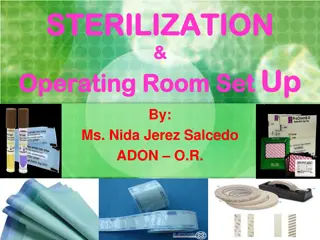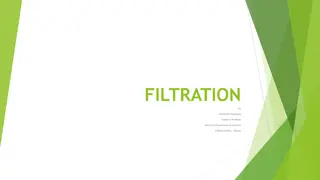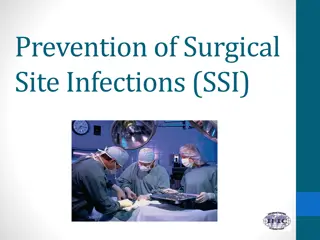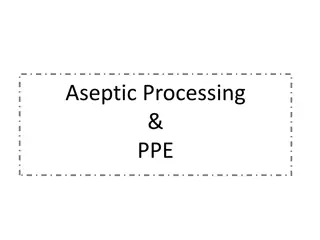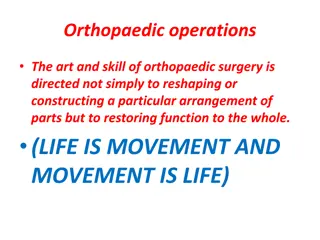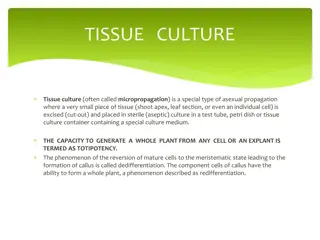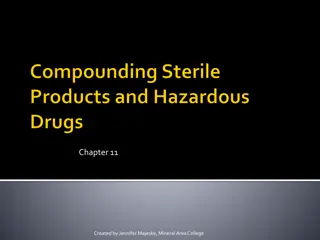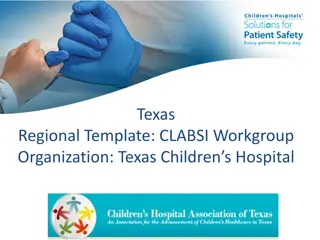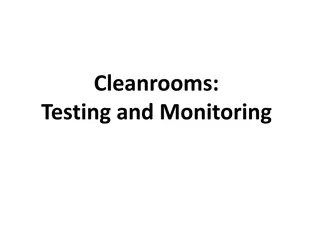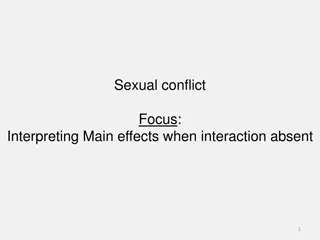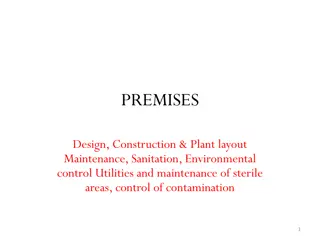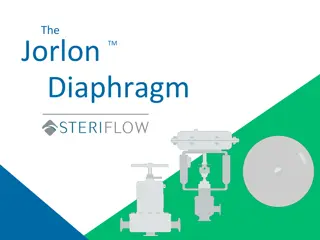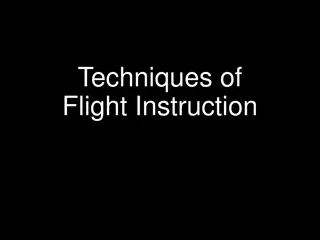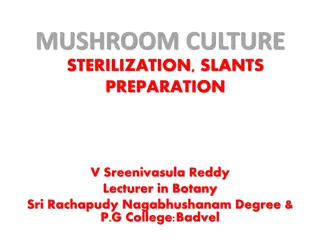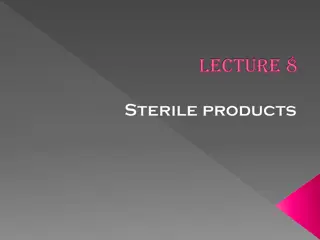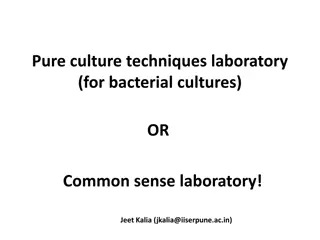Improving Hand Hygiene Compliance and Reducing Unnecessary Glove Use in Healthcare Settings
In healthcare settings, proper hand hygiene is crucial for infection prevention. Despite the common use of gloves, studies show low hand hygiene compliance rates when gloves are utilized, leading to cross-contamination risks. A quality improvement program aims to enhance hand hygiene compliance, inc
0 views • 13 slides
Surgical Prophylaxis and Antimicrobial Selection Guidelines in Surgery
Surgical prophylaxis involves administering antibiotics before contamination of previously sterile tissues to prevent infections. Common pathogens in surgical site infections include skin flora like S. aureus. Antimicrobial selection is based on the surgical procedure, likely pathogens, and safety c
4 views • 19 slides
Guidelines for Intensive Care Unit (ICU) Management by Dr. Zia Arshad
Dr. Zia Arshad provides comprehensive guidelines for managing patients in the ICU, including admission criteria, monitoring protocols, handling lab investigations, communication procedures, and post-mortem care. The guidelines emphasize meticulous documentation, compassionate patient care, infection
0 views • 28 slides
Standard Precautions in Dental Settings
Standard Precautions in Dental Settings emphasize the importance of hand hygiene, proper use of personal protective equipment, aseptic techniques, clinical asepsis, and environmental surface disinfection to control infections. Adherence to these precautions minimizes the risk of spreading microorgan
0 views • 21 slides
Understanding Sterilization and Disinfection Methods in Laboratory Settings
Sterilization involves killing all microorganisms while disinfection targets pathogenic ones. Various methods like heat, filtration, radiation, and chemicals are used for effective sterilization. Physical sterilization through heat includes dry heat, direct flaming, hot air ovens, and incineration.
4 views • 21 slides
Immediate Use Compounding of Medications - Guidelines and Procedures
Immediate Use Compounding of Medications involves preparing sterile medications outside the pharmacy in urgent situations to avoid delays in patient care. This process requires following specific criteria, maintaining aseptic technique, and ensuring proper labeling. It excludes acts like reconstitut
0 views • 13 slides
Normal Flora of Human Body
Normal flora, comprising bacteria and fungi, are beneficial residents of specific body sites like the skin, colon, and vagina. These organisms, known as commensals, play a vital role in maintaining a healthy microbial balance. The internal organs are usually sterile, while different types of normal
2 views • 16 slides
Safety Measures for Growing Microorganisms in the Laboratory
In the laboratory, it is crucial to use aseptic techniques when dealing with microorganisms to prevent contamination and ensure safe growth. Understanding the importance of agar plates, Petri dishes, and incubators in creating optimal conditions for microbial growth is essential. By following proper
0 views • 25 slides
Understanding BD FACS Aria III for Efficient Cell Sorting
Learn about the BD FACS Aria III, a sterile cell sorter capable of analyzing up to 15 colors and sorting up to 4 populations simultaneously. Recommended sample concentrations, sorting procedures, and tube preparation guidelines are provided for efficient cell sorting. Discover important tips to ensu
1 views • 12 slides
Proper Sampling Procedure of Milk and Milk Products
Proper sampling of milk and milk products is crucial for accurate chemical analysis. This article covers the sampling procedures for various dairy products like milk, cream, paneer, ghee, and more. It emphasizes the importance of experienced personnel, sterile equipment for bacteriological testing,
1 views • 28 slides
Understanding Surgical Asepsis and Sterile Technique
Surgical asepsis and sterile technique are crucial in medical procedures to prevent infections. Principles, practices, and procedures ensure a sterile environment for invasive procedures. This involves maintaining asepsis and sterile conditions in operating rooms and other medical settings. Healthca
0 views • 50 slides
Eastmont Wellness Expansion Overview - September 2022
Eastmont Wellness is expanding its services to better serve patients in the Alameda Health System. The expansion includes a Dental Clinic, Eye Clinic, and Centralized Sterilization Hub. The Dental Clinic will offer adult services, the Eye Clinic will co-locate optometry and ophthalmology services, a
2 views • 6 slides
What type of gloves are used in the laboratory?
Attention to detail in scientific research and experimentation is crucial, and that includes selecting the right gloves for the lab. The gloves are vital for maintaining a sterile and safe environment, and different types of gloves are tailored to sp
5 views • 10 slides
Using Gloves to Prevent Infection in Laboratories || Sentinel Laboratories
Sentinel Laboratories, Their Laboratory gloves offer superior protection, durability and comfort, making them ideal for various scientific and industrial applications. From chemical-resistant gloves to sterile options for cleanrooms, we ensure the h
1 views • 8 slides
Utilizing Sterile Insect Technique for Aedes Aegypti Control
The Sterile Insect Technique (SIT) is a biologically-based method used to manage key insect pests by releasing sterile insects to decrease population reproduction. This technique, developed through genetic manipulation and ionizing radiation, has been instrumental in controlling insect populations l
0 views • 13 slides
Clinical Diagnosis and Assessment of Pre-Labour Rupture of the Membranes
Pre-Labour Rupture of the Membranes (RROM) is characterized by the leakage of amniotic fluid before the onset of labor, particularly when the gestational age is less than 37 weeks. Clinical diagnosis involves a thorough history evaluation and examination, including sterile speculum examination to co
0 views • 18 slides
Understanding Intravenous Infusions: Types and Administration
Intravenous infusions are sterile pharmaceutical solutions or suspensions administered via different routes into the body for various medical needs. These infusions, such as D51.2NS, play a crucial role in providing essential nutrients and medications to patients. Intravenous administration sets and
0 views • 23 slides
Exploring Neutrino Physics and Beyond with Observables and Detectors
Delve into the realm of neutrino physics, nuclear recoils, and other phenomena like sterile neutrino oscillations using detectors such as BSM and single-phase LAr inelastic NC/CC interactions. From NSI to Supernova-relevant cross-sections and accelerator-produced DM, this research journey covers a w
0 views • 5 slides
Comprehensive Guide to Surgical Procedures Preparation
This detailed guide provides step-by-step instructions on patient preparation for surgical procedures, including patient prep, setting up sterile fields, and prepping the operative site. It covers essential aspects such as emplacing a tourniquet, washing the wound, performing preoperative irrigation
1 views • 40 slides
Understanding Sterilization and Aseptic Techniques in Operating Room Setup
Explore the methods and processes of sterilization, principles of aseptic techniques, and operating room setup for patient safety. Learn terminologies related to sterilization, asepsis, sepsis, antiseptics, and disinfection to ensure a sterile environment for medical procedures.
0 views • 103 slides
Understanding Filtration: Process, Applications, and Mechanisms
Filtration is a process of separating solid particles or suspended matter from liquid or gas by passing it through a porous medium. This article discusses the definition of filtration, factors affecting its rate, applications in various industries, mechanisms involved, and different types of filtrat
1 views • 6 slides
Neutrino Detectors for NuStorm: Physics Goals and Detector Requirements
Physics goals for neutrino detectors in the NuStorm project include measuring exclusive neutrino cross sections, supporting long baseline programs, searching for sterile neutrinos, and improving measurements. Detector requirements involve reconstructing neutrino interactions, providing charge and pa
0 views • 21 slides
Prevention of Surgical Site Infections: Key Factors and Recommendations
Surgical site infections (SSIs) are a significant concern in healthcare settings, with 25% of healthcare-associated infections being SSIs. They are preventable, but still pose challenges due to multifactorial causes. Risk factors include uncontrolled diabetes, obesity, smoking, and length of preoper
2 views • 28 slides
Understanding Aseptic Processing and Contamination Control in Cleanroom Environments
Aseptic processing involves maintaining a sterile environment to prevent contamination in cleanroom settings. The presence of non-viable and viable particulate contamination, such as dust and live microorganisms, poses challenges. Sources of contamination include equipment, structures, surfaces, and
0 views • 29 slides
The Art of Orthopaedic Surgery: A Comprehensive Guide
Orthopaedic surgery involves intricate planning, precise execution, and specialized equipment to restore function to the body. From preoperative assessments to intraoperative techniques like radiography and magnification, this field aims to enhance mobility and quality of life. The use of tourniquet
0 views • 22 slides
Understanding Tissue Culture and Explant Selection in Plant Micropropagation
Tissue culture, or micropropagation, involves propagating plants from small tissue pieces in sterile culture. The process of dedifferentiation and redifferentiation allows for the regeneration of whole plants from individual cells or explants. Explants, selected from meristematic tissue, develop cal
0 views • 47 slides
Plant Tissue Culture Methods for Growth and Reproduction Study
Plant tissue culture methods such as root tip culture, shoot-tip culture, leaf culture, flower culture, and anther and pollen culture allow for the study of growth, reproduction, and genetic variations in plants. These techniques involve culturing various plant parts under sterile conditions to inve
1 views • 20 slides
Surgical Hand Antisepsis in the Operating Room Setting
Achieving effective surgical hand antisepsis is crucial in the operating room to reduce the risk of surgical site infections. This involves using antimicrobial agents and sterile brushes to remove debris and microorganisms, reduce microbial counts, and prevent rapid growth. The process requires equi
0 views • 21 slides
Understanding Equipment and Techniques in Intravenous Preparation
Explore the role and function of equipment like syringes, needles, IV sets, catheters, etc., in IV preparation. Learn about IV solution characteristics, aseptic technique in pharmacy, handling hazardous drugs, and quality assurance programs in hospitals. Discover the importance of aseptic technique
0 views • 69 slides
Best Practices for CLABSI Prevention in Texas Regional Hospitals
This presentation outlines the insertion and maintenance bundle elements for central line-associated bloodstream infection (CLABSI) prevention in Texas regional hospitals, including hand hygiene, sterile procedures, dressing maintenance, and data collection methods. Improvement strategies such as op
0 views • 14 slides
Principles of Cleanroom Testing and Monitoring
Cleanrooms play a critical role in maintaining the quality of air and controlling contamination levels to ensure a sterile environment. The testing principles cover aspects such as air volume, velocity, direction, filter installation, air movement control, and additional tests like temperature and l
0 views • 59 slides
Understanding Effects of Sexual Conflict on Female Longevity in Drosophila
Exploring the impact of male ejaculate protein on the lifespan of mated female Drosophila by analyzing egg production, fertility, mating costs, and the interaction between different treatments. Results suggest that fertile and sterile females, as well as those exposed to high-cost vs. low-cost males
0 views • 7 slides
Guidelines for Premises Design, Construction, and Plant Layout in Pharmaceutical Manufacturing
This comprehensive guide covers the key aspects of premises design, construction, and plant layout in pharmaceutical manufacturing. It delves into considerations such as location selection, environmental controls, utilities, maintenance of sterile areas, and contamination control. From site developm
0 views • 48 slides
Understanding Sterilization Methods and Equipment for Pharmaceutical Products
Sterilization is crucial in the production of sterile pharmaceuticals, involving the removal or destruction of microorganisms to ensure product safety. Methods include physical (moist heat, dry heat, irradiation), chemical (gaseous, liquid sterilants), and non-thermal techniques like ethylene oxide
0 views • 35 slides
Essential Disposable Cleanroom Garments: Gloves, Masks, Gowns, and Access Mats
Discover the importance of using high-quality disposable cleanroom garments to maintain hygiene and safety in sterile environments. From cleanroom gloves and masks to surgical gowns and access mats, ensure maximum protection for both personnel and pr
1 views • 8 slides
Enhancing Pharmaceutical Process Reliability with JorlonTM Diaphragms
Aseptic valve components are crucial in the pharmaceutical industry, especially the diaphragms in automated control valves. JorlonTM Diaphragm, a pure PTFE material, provides a sterile barrier, increasing valve life and reducing downtime risks due to failures. Tested for durability, JorlonTM offers
0 views • 16 slides
Effective Techniques for Flight Instruction
Flight instructors play a crucial role in ensuring safe flying by addressing obstacles to learning, maintaining a positive exchange of controls, adhering to sterile cockpit rules, and utilizing integrated flight instruction methods. Inadequate training and unfair treatment can hinder student progres
0 views • 38 slides
Mushroom Culture Sterilization and Slants Preparation Methods
Learn about the sterilization methods for glassware, agar medium, and culture medium in mushroom culture. Understand the preparation of agar slants and culture slants to maintain a sterile environment for successful cultivation. Follow detailed procedures for sterilization at different levels in the
0 views • 17 slides
Understanding Sterile Pharmaceutical Products Development
Sterile products are dosage forms free of viable microorganisms, crucial for parenteral administrations to ensure therapeutic efficacy and patient safety. This article covers the importance of sterile products in the pharmaceutical industry, the development objectives, different routes of administra
0 views • 31 slides
Mastering Bacterial Culture Techniques in the Laboratory
Explore the fundamental steps and principles involved in culturing bacteria in a laboratory setting to achieve optimal growth. Understand the importance of providing essential nutrients, maintaining specific conditions, and following sterile protocols to prevent contamination. Enhance your knowledge
0 views • 22 slides
